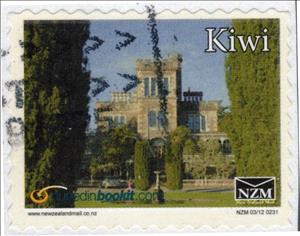Stamp: Larnach Castle, Dunedin - Large Format (Personalized and Private Mail Stamps 2012)
Larnach Castle, Dunedin - Large Format (Personalized and Private Mail Stamps 2012)
01 March (Personalized and Private Mail Stamps ) within release New Zealand : New Zealand Mail (NZM) goes into circulation Stamp Larnach Castle, Dunedin - Large Format face value Kiwi No Face Value
| Stamp Larnach Castle, Dunedin - Large Format in catalogues | |
|---|---|
| Colnect codes: | Col: NZ-NZM 2012-0231A |
Stamp is square format.
Dunedin Series Imprint: NZM 03/12 0231 10 Designs all with same serial numberAlso in the issue New Zealand : New Zealand Mail (NZM):
- Stamp - Resene - Hokey Pokey - Large Format face value Kiwi;
- Stamp - Clock Tower, University of Otago - Large Format face value Kiwi;
- Booklet - Dunedin Series Booklet face value 10*Kiwi;
- Stamp - Dunedin Town Square - Large Format face value Kiwi;
- Stamp - Larnach Castle, Dunedin - Large Format face value Kiwi;
- Stamp - New Zealand Fur Seal - Large Format face value Kiwi;
- Stamp - New Zealand Fur Seal - Large Format face value Kiwi;
- Stamp - New Zealand Fur Seals - Large Format face value Kiwi;
- Stamp - Olveston House, Dunedin - Large Format face value Kiwi;
- Stamp - Resene - Barbecue - Large Format face value Kiwi;
- Stamp - Resene - Bungy - Large Format face value Kiwi;
- Stamp - Resene - Geyser - Large Format face value Kiwi;
- Stamp - Resene - Jandal - Large Format face value Kiwi;
- Stamp - Resene - Koru - Large Format face value Kiwi;
- Stamp - Resene - Middle Earth - Large Format face value Kiwi;
- Stamp - Resene - Pavlova - Large Format face value Kiwi;
- Stamp - Resene - Pohutukawa - Large Format face value Kiwi;
- Stamp - Resene - Surf's Up - Large Format face value Kiwi;
- Booklet - Resene Series It’s all over New Zealand Booklet face value 10*Kiwi;
- Stamp - Speight's Beer Tap, Dunedin - Large Format face value Kiwi;
- Stamp - Stained Glass Window of Locomotive - Large Format face value Kiwi;
- Stamp - Yellow Eyed Penguin, Hoiho - Large Format face value Kiwi;
Stamp Larnach Castle, Dunedin - Large Format it reflects the thematic directions:
A building or edifice is a structure with a roof and walls standing more or less permanently in one place, such as a house or factory. Buildings come in a variety of sizes, shapes and functions, and have been adapted throughout history for a wide number of factors, from building materials available, to weather conditions, to land prices, ground conditions, specific uses and aesthetic reasons. Buildings serve several needs of society – primarily as shelter from weather, security, living space, privacy, to store belongings, and to comfortably live and work. A building as a shelter represents a physical division of the human habitat (a place of comfort and safety) and the outside (a place that at times may be harsh and harmful).
A castle (from Latin: castellum) is a type of fortified structure built in Europe and the Middle East during the Middle Ages by European nobility. Scholars debate the scope of the word castle, but usually consider it to be the private fortified residence of a lord or noble. This is distinct from a palace, which is not fortified; from a fortress, which was not always a residence for nobility; and from a fortified settlement, which was a public defence – though there are many similarities among these types of construction. Usage of the term has varied over time and has been applied to structures as diverse as hill forts and country houses. Over the approximately 900 years that castles were built, they took on a great many forms with many different features, although some, such as curtain walls and arrowslits, were commonplace.
Tourism is travel for pleasure or business; also the theory and practice of touring, the business of attracting, accommodating, and entertaining tourists, and the business of operating tours. Tourism may be international, or within the traveller's country. The World Tourism Organization defines tourism more generally, in terms which go "beyond the common perception of tourism as being limited to holiday activity only", as people "traveling to and staying in places outside their usual environment for not more than one consecutive year for leisure, business and other purposes". Tourism can be domestic or international, and international tourism has both incoming and outgoing implications on a country's balance of payments. Today, tourism is a major source of income for many countries, and affects the economy of both the source and host countries, in some cases being of vital importance.



